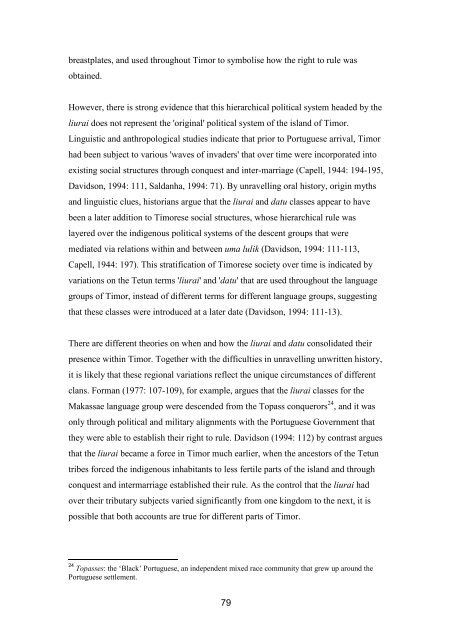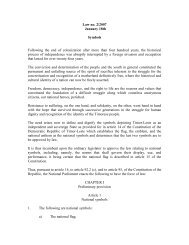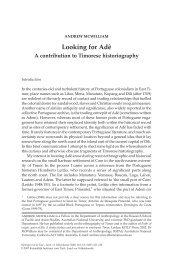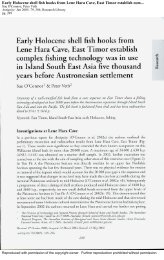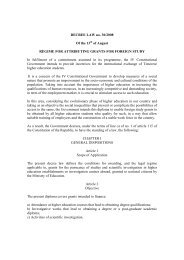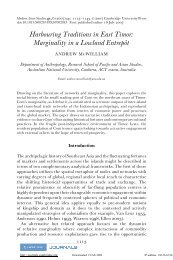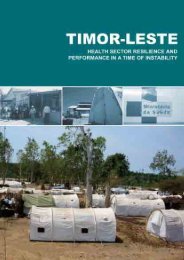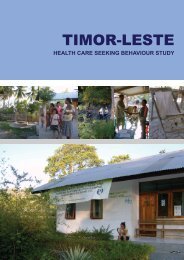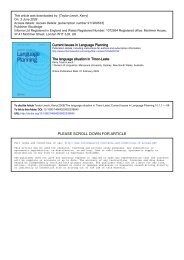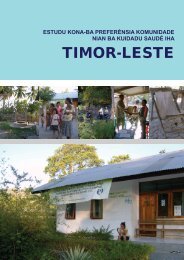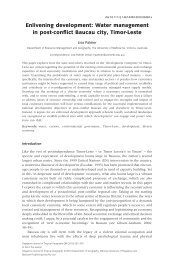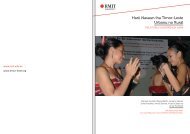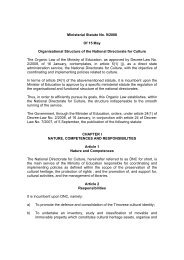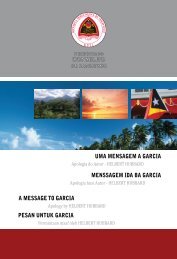Local Governance in Timor-Leste - Secretaria de Estado da Arte e ...
Local Governance in Timor-Leste - Secretaria de Estado da Arte e ...
Local Governance in Timor-Leste - Secretaria de Estado da Arte e ...
- No tags were found...
You also want an ePaper? Increase the reach of your titles
YUMPU automatically turns print PDFs into web optimized ePapers that Google loves.
eastplates, and used throughout <strong>Timor</strong> to symbolise how the right to rule wasobta<strong>in</strong>ed.However, there is strong evi<strong>de</strong>nce that this hierarchical political system hea<strong>de</strong>d by theliurai does not represent the 'orig<strong>in</strong>al' political system of the island of <strong>Timor</strong>.L<strong>in</strong>guistic and anthropological studies <strong>in</strong>dicate that prior to Portuguese arrival, <strong>Timor</strong>had been subject to various 'waves of <strong>in</strong>va<strong>de</strong>rs' that over time were <strong>in</strong>corporated <strong>in</strong>toexist<strong>in</strong>g social structures through conquest and <strong>in</strong>ter-marriage (Capell, 1944: 194-195,Davidson, 1994: 111, Sal<strong>da</strong>nha, 1994: 71). By unravell<strong>in</strong>g oral history, orig<strong>in</strong> mythsand l<strong>in</strong>guistic clues, historians argue that the liurai and <strong>da</strong>tu classes appear to havebeen a later addition to <strong>Timor</strong>ese social structures, whose hierarchical rule waslayered over the <strong>in</strong>digenous political systems of the <strong>de</strong>scent groups that weremediated via relations with<strong>in</strong> and between uma lulik (Davidson, 1994: 111-113,Capell, 1944: 197). This stratification of <strong>Timor</strong>ese society over time is <strong>in</strong>dicated byvariations on the Tetun terms 'liurai' and '<strong>da</strong>tu' that are used throughout the languagegroups of <strong>Timor</strong>, <strong>in</strong>stead of different terms for different language groups, suggest<strong>in</strong>gthat these classes were <strong>in</strong>troduced at a later <strong>da</strong>te (Davidson, 1994: 111-13).There are different theories on when and how the liurai and <strong>da</strong>tu consoli<strong>da</strong>ted theirpresence with<strong>in</strong> <strong>Timor</strong>. Together with the difficulties <strong>in</strong> unravell<strong>in</strong>g unwritten history,it is likely that these regional variations reflect the unique circumstances of differentclans. Forman (1977: 107-109), for example, argues that the liurai classes for theMakassae language group were <strong>de</strong>scen<strong>de</strong>d from the Topass conquerors 24 , and it wasonly through political and military alignments with the Portuguese Government thatthey were able to establish their right to rule. Davidson (1994: 112) by contrast arguesthat the liurai became a force <strong>in</strong> <strong>Timor</strong> much earlier, when the ancestors of the Tetuntribes forced the <strong>in</strong>digenous <strong>in</strong>habitants to less fertile parts of the island and throughconquest and <strong>in</strong>termarriage established their rule. As the control that the liurai hadover their tributary subjects varied significantly from one k<strong>in</strong>gdom to the next, it ispossible that both accounts are true for different parts of <strong>Timor</strong>.24 Topasses: the ‘Black’ Portuguese, an <strong>in</strong><strong>de</strong>pen<strong>de</strong>nt mixed race community that grew up around thePortuguese settlement.79


